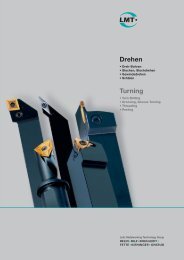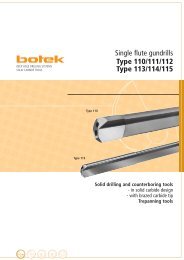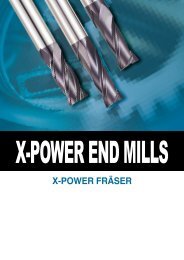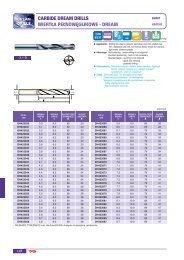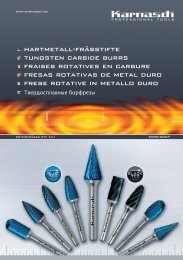Gear Cutting Tools
Hobs - Torion
Hobs - Torion
- No tags were found...
Create successful ePaper yourself
Turn your PDF publications into a flip-book with our unique Google optimized e-Paper software.
Coated solid-type hobs with a high<br />
number of gashes are ideally suited<br />
to high-performance hobbing<br />
of straight spur gears. Solid-type<br />
hobs are more stable than any<br />
type of composite hob. The high<br />
number of gashes permits a high<br />
rate of chip removal, and the tool<br />
life is increased substantially by<br />
the coating and, where applicable,<br />
re-coating.<br />
Compared to conventional hobs,<br />
high-performance hobs are required<br />
to have:<br />
■ A higher tool life quality;<br />
■ Shorter machining times;<br />
■ At least equal if not superior<br />
gear quality.<br />
These requirements are interrelated,<br />
such that measures which for<br />
example reduce the machining<br />
time may have a detrimental effect<br />
upon the tool life or the gear<br />
quality.<br />
Hobs can be optimized only in<br />
consideration of the machining environment.<br />
Based upon the geometry<br />
and the material and quality<br />
characteristics of the gear in<br />
question, the hob design and<br />
cutting parameters must be<br />
matched such that the requirements<br />
are broadly fulfilled.<br />
Tip chip thickness<br />
The tip chip thickness is an important<br />
criterion for hob design and<br />
optimization.<br />
The tip chip thickness is the theoretical<br />
maximum chip thickness<br />
which can be removed by the hobs<br />
teeth.<br />
The following hob characteristics<br />
and cutting parameters are taken<br />
into account during calculation of<br />
the tip chip thickness:<br />
■ Module<br />
■ Number of teeth<br />
■ Helix angle<br />
■ Profile displacement<br />
■ Cutter diameter<br />
■ Number of gashes<br />
■ Number of starts<br />
■ Axial feed<br />
■ <strong>Cutting</strong> depth.<br />
Increased tool life quality<br />
An increase in the number of<br />
gashes is a design measure with a<br />
decisive, positive effect upon the<br />
tool life quality. The increase in the<br />
number of gashes results in the<br />
volume to be machined being distributed<br />
over a greater number of<br />
cutter teeth, and the tip chip thicknesses<br />
being reduced.<br />
Smaller tip chip thicknesses require<br />
smaller cutting forces, which<br />
reduce the stresses placed upon<br />
the cutting edges of the hob and<br />
lead to lower wear. Lower tip chip<br />
thicknesses enable higher tool life<br />
qualities to be achieved.<br />
Assuming that the hob diameter<br />
remains unchanged, however, an<br />
increase in the number of gashes<br />
reduces the number of regrinds<br />
which are possible. If the number<br />
of gashes is selected so that only<br />
one to three regrinds are possible,<br />
the hob is described as an superfine-tooth<br />
cutter.<br />
Hobs with 20 to 30 gashes and a<br />
useful tooth length for approximately<br />
10 regrinds are described<br />
as multi-tooth cutters.<br />
Whether multi-tooth or superfine<br />
tooth hobs are the ideal tools for a<br />
specific gear hobbing task must<br />
be determined by means of a cost<br />
analysis. The cost structure and<br />
capacity exploitation of the user's<br />
installation are also decisive factors.<br />
Developments over recent years<br />
have shown that in the majority of<br />
cases, the multi-tooth cutter is the<br />
most suitable tool.<br />
A cutter with a high number of<br />
gashes also generates a denser<br />
envelope network, i.e. the profile<br />
form of the gear is improved. This<br />
is particularly significant for workpieces<br />
with a small number of<br />
teeth.<br />
δ x [mm] =<br />
2<br />
fa<br />
·<br />
cos β 0<br />
sin α n<br />
4 · d a0<br />
δ x<br />
f a<br />
δ x [mm] = depth of the feed marking<br />
f a [mm/WU] = axial feed<br />
β 0<br />
= helix angle<br />
α n<br />
= pressure angle<br />
d a0 [mm] = tip circle diameter of the hob<br />
d<br />
Depth of the feed markings<br />
20



